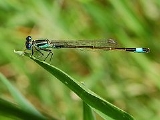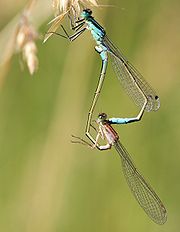
Blue-tailed Damselfly
Encyclopedia
The Blue-tailed Damselfly, Ischnura elegans, is a European damselfly
.
Adult male Blue-tailed Damselflies have a head and thorax patterned with blue and black. They have a largely black abdomen with very narrow pale markings where each segment joins the next. Segment eight, however, is entirely pale blue.
Female Blue-tailed Damselflies come in a variety of colour forms, including a pink form, a violet form and a pale green form. Purple/violet, pink and green forms are juvenile, with the colour darkening as the damselfly ages. Mature female damselflies are usually brown/green, or blue which is an andromorph form.
 Damselfly nymphs are aquatic, and prey on small aquatic insects or other aquatic larvae. The adult damselflies prey on small flying insects, caught using their legs like a basket to scoop the prey up while flying, or insects taken from leaves.
Damselfly nymphs are aquatic, and prey on small aquatic insects or other aquatic larvae. The adult damselflies prey on small flying insects, caught using their legs like a basket to scoop the prey up while flying, or insects taken from leaves.
At rest, the wings of most damselfly species are held back together, unlike dragonflies, which rest with their wings out flat.
Damselfly
Damselflies are insects in the order Odonata. Damselflies are similar to dragonflies, but the adults can be distinguished by the fact that the wings of most damselflies are held along, and parallel to, the body when at rest...
.
Adult male Blue-tailed Damselflies have a head and thorax patterned with blue and black. They have a largely black abdomen with very narrow pale markings where each segment joins the next. Segment eight, however, is entirely pale blue.
Female Blue-tailed Damselflies come in a variety of colour forms, including a pink form, a violet form and a pale green form. Purple/violet, pink and green forms are juvenile, with the colour darkening as the damselfly ages. Mature female damselflies are usually brown/green, or blue which is an andromorph form.

At rest, the wings of most damselfly species are held back together, unlike dragonflies, which rest with their wings out flat.

